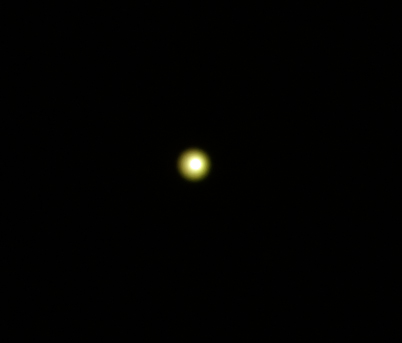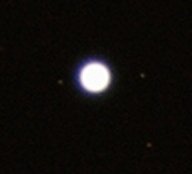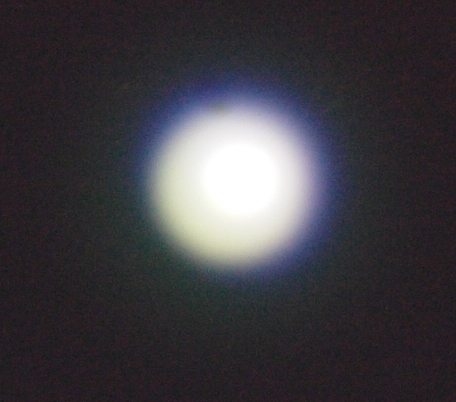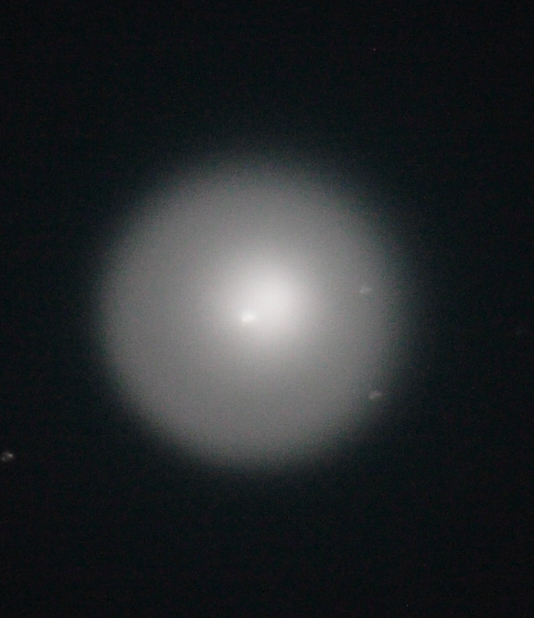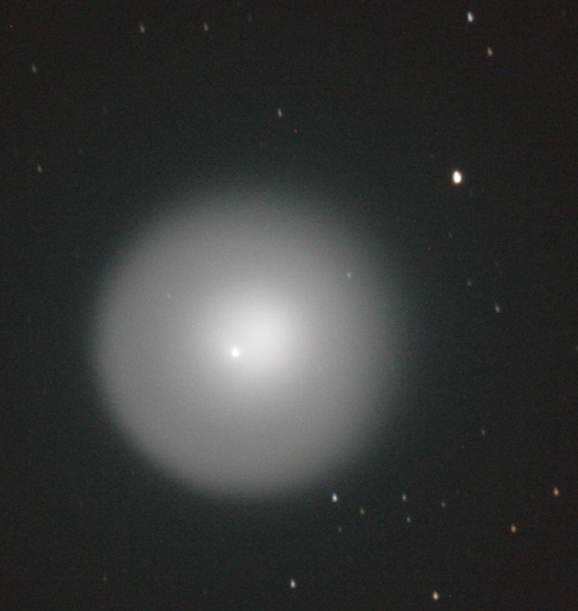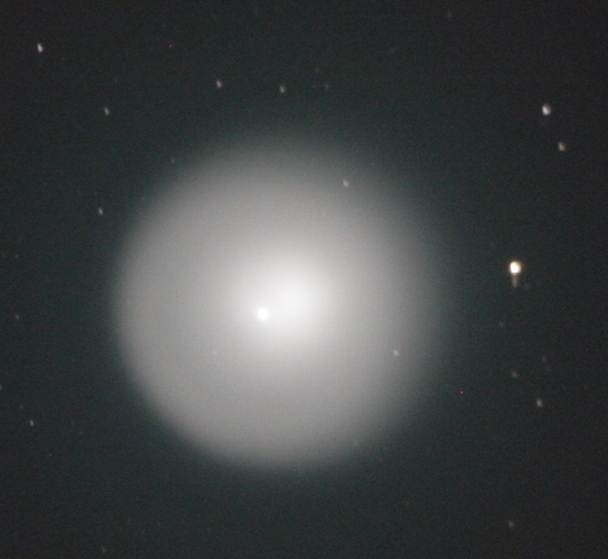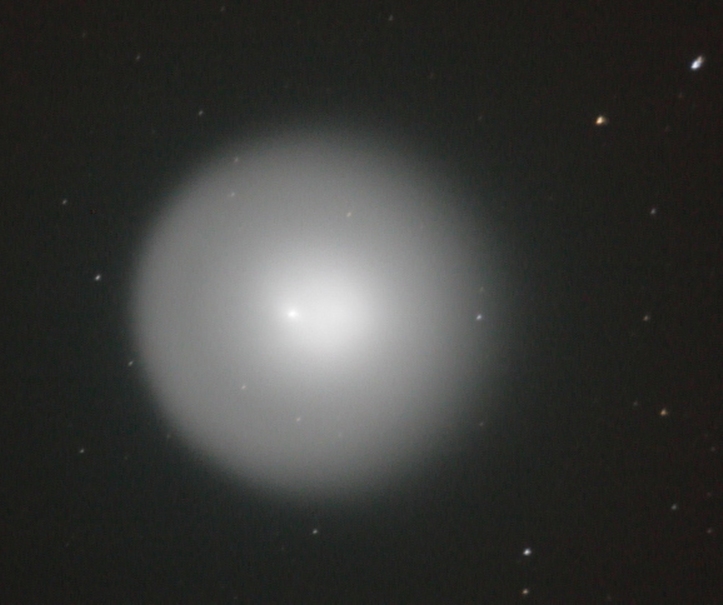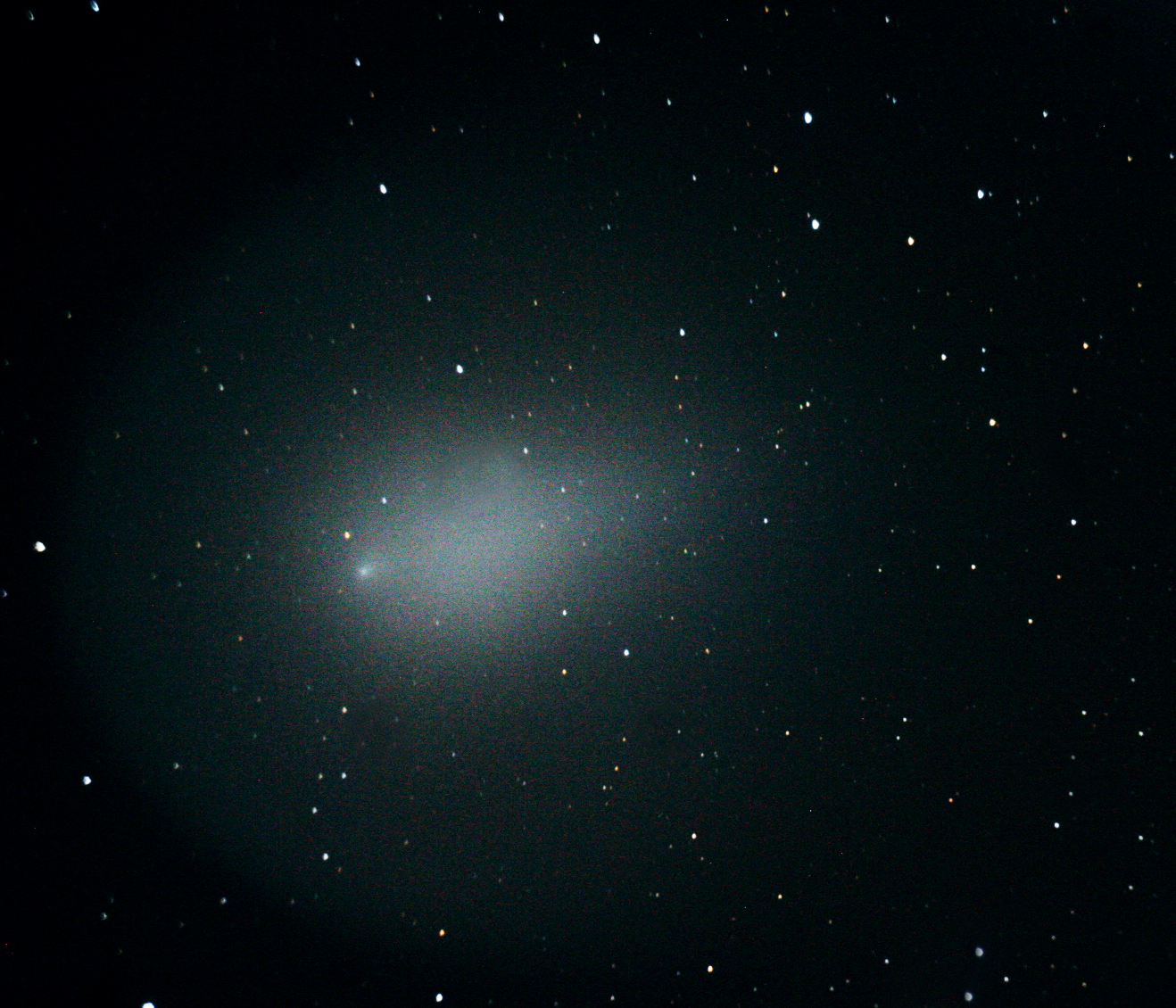Day 1,
October 24th, 2007
October 24th arrived like
any other fall day here in
northern Ohio.
It was about 50 degrees outside and clear. Night-time temperatures were
beginning to drop into the high 30's and low 40's. Many of the leaves
had
fallen by now and those that remained were vividly displaying their
post chloroformic hues. The Moon was
full and overhead
most of the night so I didn't have plans for shooting when I got home
from
working the 3-11pm shift. Since I was working 3-11pm shift I awoke
about noonish and proceeded to check my
email. I was aware
that Comet Holmes was out there. I’ve been watching the photos posted
by the
guys with astrographs and sbig cameras. At
17.5 magnitude, however, Comet Holmes was
not even near the top
of my priority list of things to check out.
On October 24th, however, all that
changed. It
started with a rather inconspicuous post buried amongst a few other
hundred I
received that day. It read as follows:
Juan Antonio Henríquez
Santana (MPC J51) reports a
outburst of Comet 17P/Holmes. Observations during the night of 2007
October
23/24 show that the comet is some 7 magnitudes brighter. The outburst
has been
confirmed by Gustavo Muler (MPC J47) and
Ramon Naves
& Montse Campàs
(MPC
213).Wed, 24 Oct 2007 02:34:25 -0000
Now, I’ve heard of Messiers Santana and Muler
and know of their good reputations. “This could be
serious.” I remember thinking. And hour and a half later the following
mail
came through. Dear
Ramon, After
seeing your e-mail, I looked for 17P/Holmes and found
what appears to be a yellowish, 7.1 magnitude star at the comet's
position.
With averted vision I may have seen a faint coma or maybe not.
Moonlight made itdifficult to be certain.
Is this "star"
actually 17P? Does this fit with your observation? If so, this is a
remarkable
object. I used a 25cm reflector at 76x and
214x on
Oct. 24, 4:10 UT.
Thank you,
Bob King, Duluth, Minn. USA
Now, things were really
looking up. Not only was there a comet out there visible in my scopes,
but it
was observed from the continental US !
“Hey, if Bob
from Duluth
can
see it, so can I!”
During the day while I was
waiting for nightfall, the following email came through. This was the
icing on
the cake. Confirmation that the comet really was as stated: Hello
Ramon and all, yes,
the outburst is real, and we congratulate wuth
Juan
Antonio Henríquez Santana and our spanish collegues for the
discovery of this extremely interesting phenomena. Right now we are
performing
some follow-up of the outburst remotely from RAS-NM. Here is a preview:
the
proper motion of the comet is evident, as well as its extreme
brightness
(severe blooming on 60 sec image through a 25nm reflecotr
+ CCD):http://tinyurl.com/ywgy7g
More on
this later...Kind regards,Giovanni Sostero
and Ernesto Guido (AFAM, CARA)Wed, 24 Oct 2007
13:36:37 +0200
I was happy as a bug in
a rug. “It doesn’t get much better than this”, I remember thinking. Wrong! The next email knocked
my socks off…………. Hello Giovanni and all, The
comet is now naked eye at mag.
4.0! Here are my observations over the past 10 hours: After hearing of
Ramon
Naves' observation last night on comet-images, I looked at 17P/Holmes
with a
25cm reflector at 76x and 214x on Oct. 24,
4:10 UT.
The comet was a mag. 7.1 "star" with a
yellow hue. This morning (Oct. 24, 11:15UT), the moon was out of the
sky and seeing was
excellent. To my amazement, 17P had brightened to naked eye visibility
being
nearly equal to 48 Per at visual mag.
4.0. In the same telescope, the coma showed an intense, nearly stellar
false
nucleus about 2.5"-3" across set in a small, 10" diameter, much
fainter, fuzzy disklike coma. The nucleus
was
distinctly yellow. The comet's appearance was very reminiscent of McNaught last winter when seen in the daytime
sky. What a
sight! Bob King, Duluth,
Minn. USA,
Wed, 24 Oct 2007
07:06:44
–0500
4th
Magnitude? Now, it’s a
binocular
object. Naked eye, even, from a dark site.
This
changes everything. Could it be true? Dear
colleagues, I
confirmed the unbelievable super outburst of 17P/Holmes beside Tsurumi River
in Yokohama City,
Kanagawa, Japan! It is visible with
naked
eyes in a large city! Wed, 24 Oct 2007 22:43:24 +0900 (JST)
Yes, it’s true. Now, if it
will just stay clear until I get home from work after Midnight so I can
see the
comet. Before leaving for work I sent out the following email to let my
fellow
amateur at the Black /river Astronomical Society know what was
transpiring: Hi,
Group, Well, the race
is on. Over the last 24 hours Comet 17/P Holmes has gone from an object
most of
couldn't see in our telescopes to a daytime viewing comet. Magnitude
estimates
from, like right now, in Japan,
are coming in at 2nd magnitude
and still brightening. It's interesting that this comet did exactly the
same
thing in past apparitions. The good news for us is that this comet is
still 2.5
au out in favorable skies for us northerners. Look in Perseus which is
rising
in the east at dusk for a yellow stellar looking object. Dave G. just
sent this
finder aid that will prove quite useful.
Enjoy,Astronomically, John
I did some quick searches on
the web and learned a little about this comet..............
History
of Comet 17P/Holmes
The
comet was discovered by
Edwin Holmes on November 6, 1892 whilst conducting regular observations
of the
Andromeda Galaxy (M31). It was confirmed by Edward Walter Maunder
(Royal
Observatory, Greenwich, England), William Henry Maw (England), and Kidd (Bramley, England). The comet was
independently
discovered by Thomas David Anderson (Edinburgh,
Scotland) on
November 8 and by John Ewen Davidson (Mackay, Queensland,
Australia)
on November 9 (who had previously, on 19 July 1889, discovered C/1889
O1, the
first comet discovery from Queensland). The first elliptical orbits
were independently calculated by Heinrich Kreutz
and
George Mary Searle. Additional orbits eventually established the
perihelion
date as June 13 and the orbital period as 6.9 years. These calculations
proved
that this comet was not a return of 3D/Biela. The 1899 and 1906 appearances
were observed, but the comet was lost after 1906 until recovered on
July 16,
1964 by Elizabeth Roemer (US Naval Observatory, Flagstaff, Arizona,
USA) aided
by computer predictions by Brian G. Marsden,
the
comet has been observed on every return since.
Source: Wikopedia
More
History of Comet 17P/Holmes
In 1892, the comet underwent a
similar outburst to the one that is occurring today. According to The Cosmic Mirror, over 100 years ago, when
the
comet had
its earlier brightening, it stayed brilliant for more than a week,
remaining
visible to the unaided eye for three weeks. The size of the comet's
coma
appeared to increase. Then, a couple months later, a second outburst
occurred
in Holmes. It is unknown if the comet's sudden brightening will follow
this
previous event, but keep your eye on it to find out!
Immediately upon
learning of the comet I fired an email message off to fellow comet
hunter, Dave
G. He responded back in kind almost immediately with the following
chart of the
comet’s path through Perseus.
I also got this email from
Larry back pretty quickly: I've been so lost in work
it was pure joy to get this type of news. Think you could also include
a few
clear sky nights, John?Thanks
for the alert. Larry J. Wed, 24 Oct 2007 13:23:15 -0400 (EDT) ljano@apk.net
Larry responded back rather
quickly as did Dave Gulyas and Dave Lengyel. I’m glad they posted
finder charts
because I still hadn’t found time to do any serious searches for
information. Folks, I'm
hoping this works.I'm
sending you a .pdf file for tonight's
position of comet 17P/ Holmes in
Perseus. It has brightened, according to reports, by 14
magnitudes!
That's about 400000 times increase in
brightness. That being said, let's hope
we
get some clearing. Dave Wed, 24 Oct 2007 14:43:20 -0400David Lengyel dave_lengyel@amherst.k12.oh.us

By afternoon
the news
was getting out and spanning the globe like wildfire. My PDA was
humming like
an angry little bee all day at work. Images started coming from the
dark parts
of the globe while information and research began coming from light
parts. This
was a long day for me, wondering if it would still be clear when I got
home
after midnight. Here’s a few short excerpts
of news I
received that afternoon:
Folks,
OK, Spaceweather has now
update their
site with the comet info. It probably will be more useful than my map. http://www.spaceweather.com/
It may clear later tonight. Dave Wed, 24 Oct 2007 14:57:14 -0400David
Lengyel dave_lengyel@amherst.k12.oh.us
Comet 17P/Holmes is
apparently undergoing a spectacular brightening.Information
and links at: <http://www.spaceweather.com/> This
object is amazing! I
have just observed it with an 8-inch f/10 Cassegrain,
boosting the power up to 163X then to 508X...the bright inner coma
seems
displaced offcenter toward p.a. 315
degrees. The
inner coma opens up into a fan toward p.a. 300, and I have noticed one
ripple,
akin to the hoods/ripples seen in Hale-Bopp
ten years
ago. The coma is uniform in brightness, aside from this fan-shape
material eminating from the central
condensation, and has a
well-defined edge. I measured the coma to be 69.3" diameter using the
drift method. The entire object has a nice yellow-white color, no sign
of any
tail. The apparent magnitude is +2.8 (estimated using Mirfak at +1.9
and the
other two bright stars adjacent to it at +3.0 each) and has remained
rather
steady all evening (first estimate at 1:15UT, Oct. 25, first
observation with a
4.5" f/8 reflector shortly after). It seemed to be a bit brighter
compared
to the 3.0 mag. star arount
3:00UT (estimated = +2.7) but was +2.8 at
5:15UT. I plan to keep a close eye on this
object as
we expect to have clear skies for the next 7 days... Wed, 24 Oct 2007 23:05:15
Day 2-3, October 25th & 26,
2007
Finally, I got home from work.
By then it was Thursday morning of the 25th. I couldn't wait to see
this comet
I had heard so much about during the day.............And, so, of
course, it was
cloudy. Oh, No!!! This is not possible..... Here’s my email from the
following
afternoon: Hello,
Group, I got home
last night @ 12:30am. Sat in my little pod until
2:30am watching
clouds whizz by. Suddenly a clear
spot develoved in front of the moon and I
quickly aligned
my goto using the moon, then focused my
30D at prime
focus of the Orion 120mm f/5.0. Then I entered the coordinates of the
comet and
it dutifully slewed to the desired location.
Another 45 minutes passed
before a sucker hole finally opened up over Perseus. I was watching
with
binoculars and found the comet immediately recognizable. It was at
least 2nd mag, BRIGHT yellow and HUGE!
Imagine Mars being yellow. That's
what the comet looks like in binoculars.I quickly rushed to the scope and looked inside. There it was. The
apparent
diameter was even more impressive in a scope. With an added bonus: In
the scope
you could see a thin outer layer of fuzziness. What a sight. This is a
must see
comet & do it quickly. There's a lot of speculation out there over
whether
this current brightening will last, or perhaps it's the comets death
toll Only
time will tell......Astronomically, John Thu, 25 Oct 2007 13:06:08
-0400John W.
O'Neal, II johnoneal@ncstargazer.com
Here’s what the comet looked
like in binoculars. Everybody was right. It looked sort of like a
planet, very
bright and quite large as compared to the stars around it. (Below
left.)
And the telescopic view was
breathtaking. (Above right.) The Comet was
about the
size of Mars in the scope, bright yellow and had a very slight fuzzy
outer
perimeter.
I got a few hours sleep and
awoke the following afternoon to find the excitement still
escalating: Dear
colleagues,17P/Holmes
got brighter furthermore! Perseus does not look
"Perseus" familiar to us due to the bright stellar object now.Thu, 25 Oct 2007 02:34:17 +0900 (JST)Seiichi
Yoshida comet@aerith.net
As of 17:00
UT Seiichi
Yoshida (Japan)
reports it has brightened to magnitude 2.8! See http://cometchasing.skyhound.com
for the latest and a finder chart. Greg Crinklaw
And the Emails were firing around our club member’s, as well…. I'm
at a loss for words. Astronomically
that's only happened to me one other time -The Shoemaker-Levy 9 impact
with
Jupiter. This is one odd duck! I just finished viewing it for about 5
minutes
through 12x50 binocs as the clouds rolled
in. It
truly is unusual to say the least. I'll be checking for sucker holes
through
the evening because I want to see what a scope might show. Larry J. Thu,
25 Oct
2007 19:52:17 -0400.
Larry
:I concur !!! The darn thing is naked eye at a full moon! At
least 2nd
mag!!
Very
yellow in color with a very
distinct coma & nucleus. I just finished viewing it with my
trusty
10x50s and my old
Jeagers 4inch F5.The view was awesome at all magnifications. Jack R
Thu, 25 Oct 2007 18:04:17 -0700 (PDT)
John
: Just spotted Comet Holmes: The darn thing is naked eye at a full moon!
At least
2nd
mag!!
Very yellow in color with a very distinct coma
& nucleus.
I just finished viewing it with my trusty 10x50s and my old
Jeagers
4inch F5. The view was awesome at all magnifications.
Jack R Thu, 25 Oct 2007 18:07:31 -0700 (PDT)
John,
when I looked at your
photos I first thought you uncharacteristically missed the mark by a
bit. Now
that I've viewed it through a scope I can see the photo's are pretty
dead on. I
kept wanting to focus and/or clean non existant dew off the lens. Almost perfectly
circular coma!
Larry J Thu, 25 Oct 2007 21:35:00 -0400
Found
it tonight, full moon,
7:45 p.m., with 10X50 handheld binocs,
then brought
out the tripod-mounted 20X80s. Astonishing sight. Clouds rolled in, but
later
cleared nicely, and there it is. This thing is especially stunning in
stereo-vision with 20X magnification. An ethereal globe illuminated
from the
center. Wow. --Bill R Thu, 25 Oct 2007 22:18:49 -0400
To All, Somehow,
someway,
TWO CONSECUTIVE NIGHTS of comet observations have been done from Northeast Ohio, aka
the 6th Circle
of
Astronomical Hades. (Not the worst spot, but you guys get the idea...)
Anyhow,
the transparency was very good, and the view was most rewarding: Oct 26.05 UT: m1 = 2.2, Dia = 3', DC = 8
...NE...Phillip J. C (North Canton, OH)
[With the naked-eye, it was just ever-so-slightly fuzzy, unlike last
night
where it looked distinctly stellar. The
view in 25x100s,
though, was the show-stopper. Folks, I really,really don't know how to describe this!
In 20+ years
as a comet observers, it's not the most
impressive
comet I've seen, but it's certainly the most surreal. The coma was about 3' in diameter. The yellow color that was so prominent last night also seems a bit muted.
The color
tonight was more of a cream color. The coma was noticeably-elongated in
a N-S direction, with a pseudo-nucleus of
~20" in
diameter noticeably displaced south of the
coma's
center. There was no diffusivity to the outer coma at all; it was a
very sharp
demarcation between background sky and coma. Think a bright planetary
nebula on
steroids, and you're close.The coma itself was not
uniform in brightness. There appeared to be a brighter patch lying E
and W of
the nucleus. There was a dimmersection,
mostly in the
northeastern quadrant (spanning about PA 345 through true north to PA
90) that
was about 2/3 of the way out from the nucleus. It looked almost like
the outer
coma on the NE quadrant had partially "peeled" away, leaving an arc
of "shadow" from PA 0 to 90.] Clear Skies, Phil Fri, 26 Oct 2007 03:39:41 -0000
The night of the 26
th,
(actually, the morning of the 26
th) arrived and found Dave
G.
shooting from his observatory and I from mine and we were comparing
notes. The
latest news we had received was that the comet’s magnitude had reached
~ 2.7
mag. We
were doing comparisons to
other stars nearby and determined that the magnitude was much closer to
2 than
2.7. Dave sent out an email mentioning this. Later estimates agreed
with our
observations. Here’s a copy of Dave’s message… I'm not
sure what to
say...??? The clouds look to have rolled in for good now (01:50EDT) but
about
01:00EDT the comet seemed to have brightened even further. Was on the
phone
with John O. at the time and he concurred. Have
allot
of images, no time to sort through right now, bed is calling. I'll post
some
images tomorrow. WOW!!! Dave G. Fri, 26 Oct 2007 02:06:49 -0400
The overall appearance was
totally different. The comet no longer resembled an out of focus star.
While
the overall AVARAGE brightness had dimmed, the central core or nucleus
had
brightened and the outer dimmer section had expanded nearly
twofold. For
lack of a better reference people started referring to the comet as a
nebulous,
almost planetary looking object.


And the core seemed to be
playing little tricks on us, depending where you were observing from,
or
perhaps what time you made your observations. In the photo below you
can
clearly see a dark ring around the core of the comet. This was reported
by many
observers. I was only one of many to get this shot.
Others captured a fan shaped
core, off center cores, cores that looked like they were jetting
material in
different directions, etc. A few photos even sported tails. These were
the
super fast systems, with serious enhancements, of course.
Day 4, October 27th,
2007
Friday afternoon I awoke to
even more news…………Even
more incredible each
night; the comet 17P (Holmes) now measures 255 arc minutes across (via
CCD
direct measure), and is easily naked eye at magnitude 1.9 visual (10 x
50
binoculars); this 5-second RGB composite was taken with the 0.4m SCT
f/3 via
CCD at 09:55 U.T. and the field measures 6 x 6 arc minutes. The nucleus
was
measured photometrically at m1=11.8,
offset
significantly from center; also note the very bright opposing (from the
nucleus) scintillating condensation equally offset from center, but in
the
opposite direction. Note that on Oct. 25, similar measures of the coma
revealed
diameter of approximately 121 arc minutes. The latest image, and a same
scale
comparison to that of October 25, is found at the link: http://www.arksky.org/smf/index.php?topic=1429.msg6902#msg690or by clicking on the ASO News on the website homepage. Dr. ClayArkansas Sky
Observatories, Harvard
MPC/ H43 (Conway) Harvard MPC/ H41 (Petit Jean
Mountain)
Harvard MPC/
H45 (Petit Jean Mtn. South)http://www.arksky.org/
Sat, 27 Oct 2007 06:00:19 -0500P. Clay Sherrod Comet-Images@yahoogroups.com
Arriving home Friday night
(Saturday morning) the outlook was grim. The Oberlin Clear Sky Clock
showed no
signs of clearing but I was firm in my belief that it would clear. I
opened up
my observatory and waited. At about 2:30am a small hole appeared and I
was able
to focus on the moon and setup my goto.

The
goto proved to be invaluable
on these nights, by the way. Shooting through holes in clouds doesn’t
give one
much time to starhop around. By the time
you see a
bright star and start to slew toward it, it’s gone. Hoping to recognize
that
star without the benefit of surrounding stars, by which to form a
reference is
next to impossible. But with a goto,
all that is unimportant. Simply set to scope to the desired coordinates
and
wait for a hole. When the hole appears, shoot. It’s really that simple.
(On a
side note, I have learned to estimate the lengths of exposures I can
take by
watching the size of the hole and the speed it’s moving at.) The
average sucker
hole in the clouds was about 20 degrees across and moving at such a
speed as to
allow 8 seconds of cloud free exposures. Since 8 seconds is where I
chose to
shoot, I merely had to watch the size of the next hole.
In this shot you can see the
almost fan shaped off center nucleus some folks described.
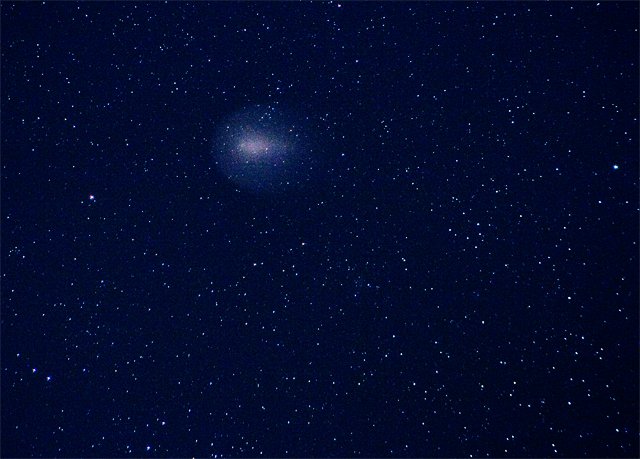
Here’s a shot through the 80mm
f/5.0, taken just to see what a wide shot with stars in the background
would
look like.
Around this time people were
starting to report a bluish colored, large outer extended coma around
the comet.
In this photo taken on the morning of the 29th, you can
begin to see
the outer coma.
Over
the next few nights the outer coma became brighter and
brighter and eventually formed an extended tail that many observers enlikened to an octopus or calamari.
Here are my shots from
the clear nights between the nights of October 24th through October 29th. Unfortunately it was cloudy here on the two nights that
the
tail was visible, so we missed out on that event in the comet’s
history.
This sequence was shot through an Orion EON ED80. 500mm @ f/6.25
October 22nd through October 29th
November 2nd through November 6th .
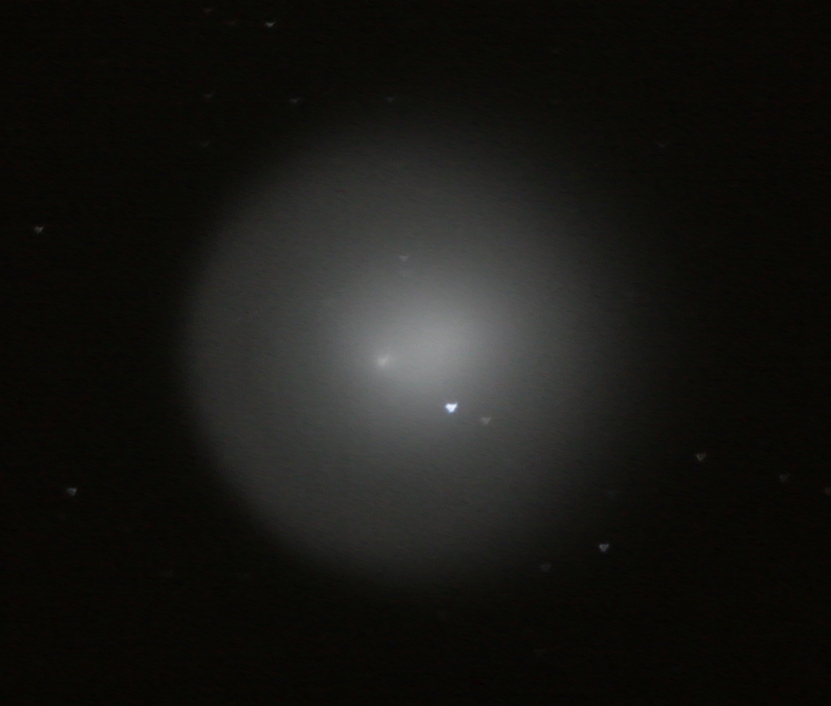
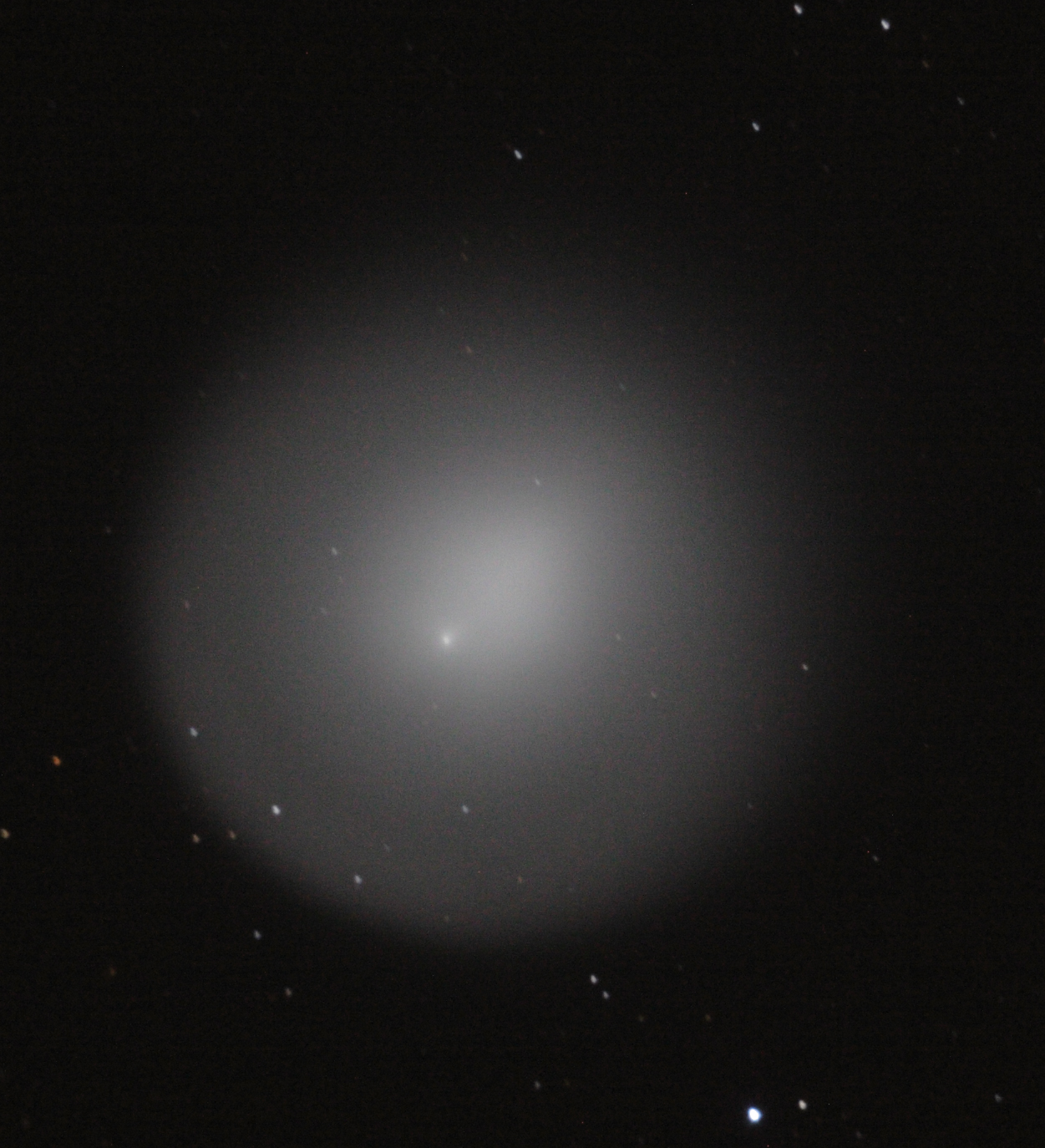

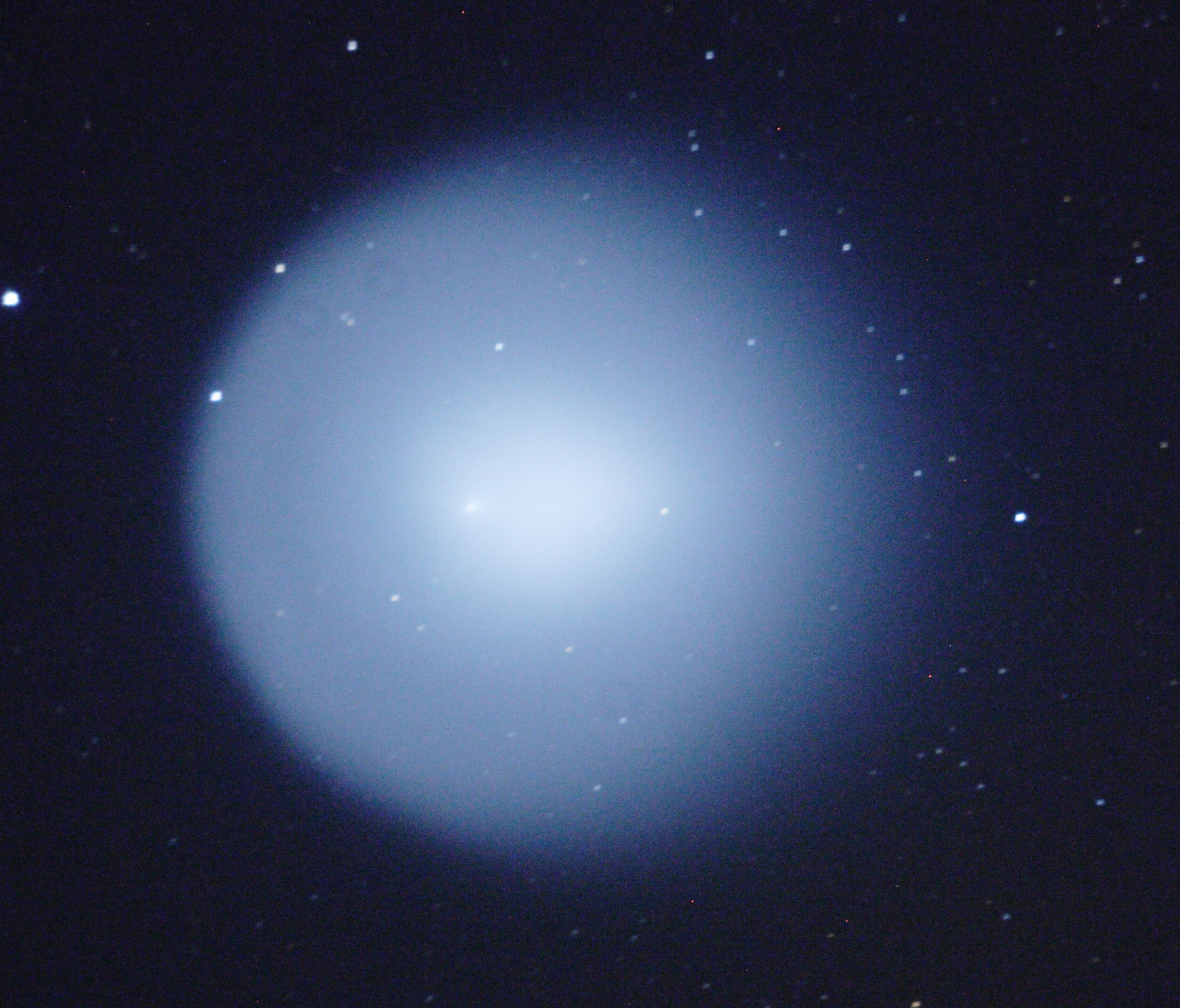
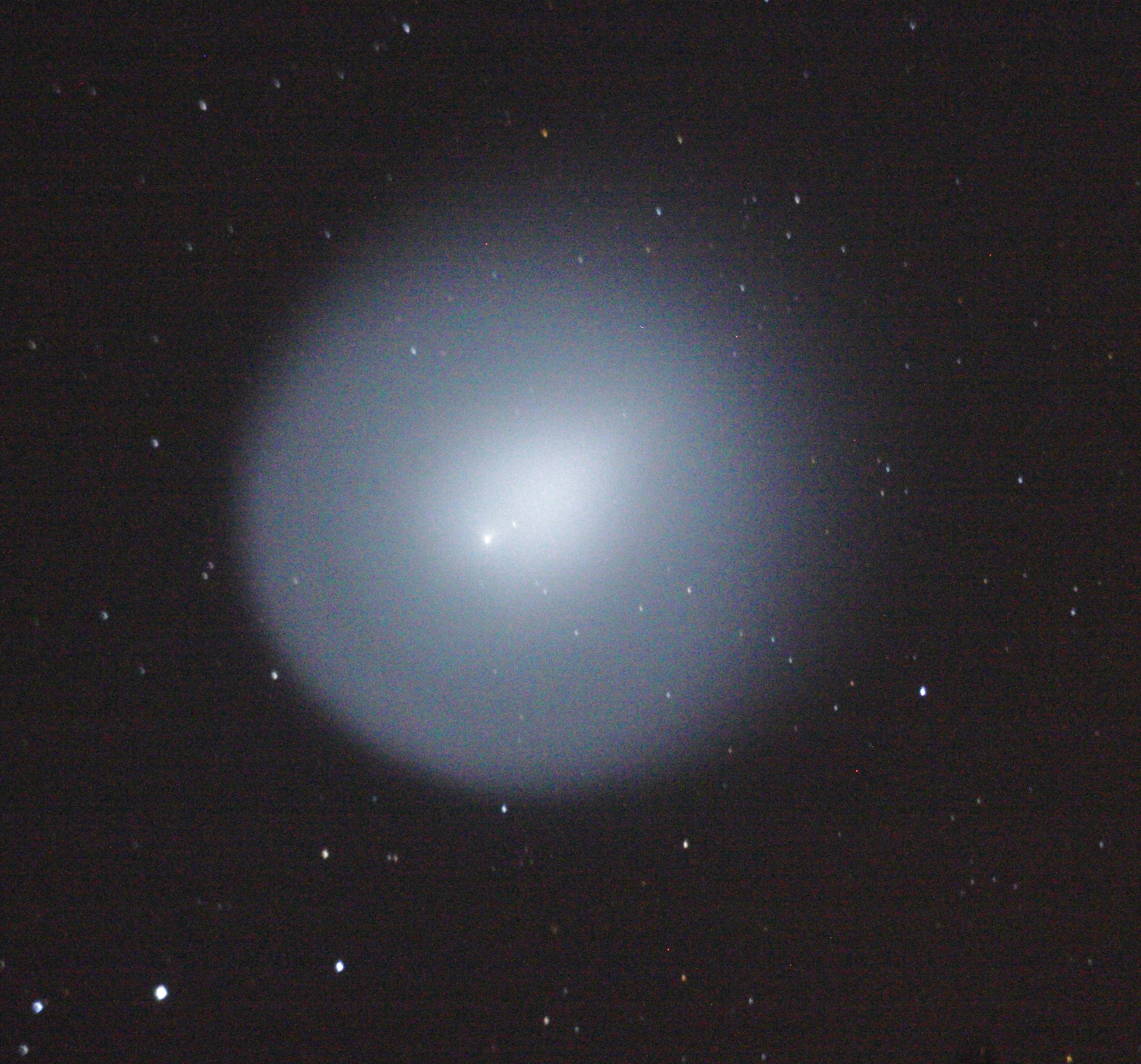
By
November 16th, 2007 the comets was over 2 degrees in diameter and so
large, I could no longer shoot it through my telescopes. Here's an
image shot with the Canon 40D and a 300mm lens.
I didn’t take a lot of images
like this because I had to grieviously overexpose the comet in order to see the outer
coma. I prefer the shorter exposures
that showed details in the inner coma.
By November 1st,
the comet had undergone quite a metamorphosis. We, as amateur
astronomers are
accustomed to measuring changes to the sky in weekly, monthly, yearly
and even
decade long timeframes. For example, we anxiously await the minima of
Algol
next week, or the new moon next month, or the big meteor shower next
year, or
even the eclipse of a lifetime in 2025. An entire industry has sprung
up to
keep us informed of what’s coming up and when and where it’s coming up.
There’s
a plethora of magazines, calendars, publications and internet resources
available
to keep us informed of the parade of nightly events in our sky.
But, nothing like this has
ever happened before. Sure, there have been lots of comets before, but
none
that have ever maintained the excitement level of Comet Holmes. Most
comets
have a pretty predictable life, you must admit. They appear, move
toward the
sun, brighten, move away from the sun, dim
and return
to oblivion. Sure they may sprout a tail and give us some really
spectacular
views, but none have ever come even remotely close to putting on a show
like
Holmes.
It’s a bit overwhelming when
an event takes place in the sky that dramatically changes overnight,
every
night. In the first week the comet went from 17.5 magnitude to 1.8 mag. If that wasn’t enough it went from just a
few arcseconds in diameter to a few
whopping degrees in
apparent diameter. Every single night
out with comet Holmes was like a night out with a totally new comet.
One night
it had a jet, next night it had two nuclei, then it had a tail, then
the tail
disconnected, then the diameter doubled, etc, etc.
I was having a rough time
staying awake at work. I found myself spending every dark, clear moment
possible in my observatory. I’ve shot thousands of photos and have have many, many
gigabytes of files
and am close to filling my external ½ terabyte drive. I curse
our
beloved
northern Ohio
weather every cloudy night, because I don’t want to miss that next big
event
that Comet Holmes has in store for us.
Note that all photos in this
article were shot by the author unless otherwise noted.

On November
18th the comet was going to cross
over Mirfac in Perseus. I really wanted to
see this event, but
weather predictions indicated it would be cloudy across the entirety of
Northern America on a line north of Cincinatti, Ohio.
We loaded up the small scope and headed for the Louisville
Astronomical Society’s site in Evansville,
Indiana. We have a
standing
invitation to visit through our club member, Randy B.
This was a difficult image to
take. Mirfac is a 2nd magnitude
star that
requires a very short exposure time. The comet is much dimmer and
requires a
much longer exposure time. I shot lots of exposures at different
exposure times
to find the one image that would show both at their best. This is one
of my
favorite memories of Comet Holmes.
This image is much more
straightforward. I shot 45 30 second exposures and then stacked them to
get
this image. It’s my second favorite, to date.

Then I took an old photo of the Moon shot with the same
scope and copied it into the image. You can see the comet’s outer
diameter is equivalent to the moon’s apparent diameter as viewed here
from
Earth

Here are two of my favorite
photos from the first two weeks of the Great Outburst of Comet 17/P
Holmes. The
first is a composite of each night’s images as compared to the moon.
The
furthest left image was taken on October 5th and the last on
November 5th.
Second is a collection of 30
second exposures taken from a fixed unguided tripod and stitched
together using
a software program called Startrails.

On November 18 Dave Gulyas
shot a couple of absolutely stunning wide angle shots. First shows the
comet,
M34, M45, Mirfac and the Mellot 20
asterism.


Second, Dave shot the Comet,
the Double Cluster and M31. Both images were quite well done and devoid
of the
problems that usually plague these types of wide angle shots. Great job, Dave!
On December 26th,
2007 the skies finally cleared and allowed me get a shot of Comet
Holmes along
with Comet Tuttle in the same field of view.









